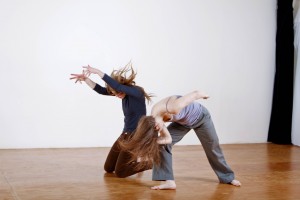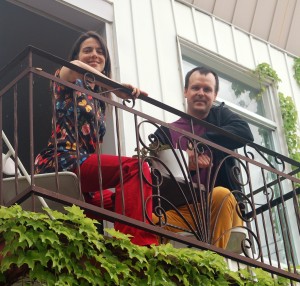Archives
Posts Tagged ‘poetry’
July 11, 2014
Interdisciplinary Project Brings P.K. Page Poems to the Stage
Scott Thomson, a composer and trombonist in Montreal, has written a suite of songs based on poems by P.K. Page that will be performed in collaboration with singer and dance artist Susanna Hood.
The group of compositions is titled The Muted Note: Songs Based on Poems by P.K. Page and was written by Scott in 2011-12. The suite of eleven songs has already been performed by Susanna and Scott in a variety of contexts, as well as released on CD in October 2013. Scott and Susanna will be promoting this CD on their upcoming tour, which has a full schedule of duo performances slotted for this autumn. The coast-to-coast tour includes more than 30 performances in nine provinces starting in September and running into November.
In addition to performances of The Muted Note, Scott and Susanna are leading discussions and workshops and looking to collaborate with interested academics. These supplementary tour activities include practice-based workshops on improvisation and setting poetry to music, as well as discussions, artist-talks, and seminars on the interdisciplinary nature of the work and its literary context.
Scott has already spoken to EMiC members Zailig Pollock, Margaret Steffler, and Sandra Djwa, as well as Ajay Heble of the Improvisation, Community and Social Practice project (who works in partnership with EMiC co-applicant Alan Filewod) about collaborating for discussions and onstage conversations. Scott and Susanna are open to other EMiC members and academics who would be interested in participating in tour activities.
Dancers Ellen Furey and Alanna Kraaijeveld (photo credit: Alejandro De Leon)
Susanna, known for her excellent vocal and dance improvisations, has created choreography for the suite in order to produce an expanded stage work of The Muted Note that she performs with three other dancers, accompanied with live music by Montreal-based quintet The Disguises. The resulting show combines composed and improvised material in both music and dance, all the time keeping Page’s poetry as the central focus. The first full stage work run of performances (with all four dancers and five musicians) will be at the Citadel Theatre in Toronto, September 5-7. The next run of shows will be in Montreal at Studio Hydro-Québec, Monument National, October 2-5 as a co-presentation by Tangente and L’Off Festival de Jazz.
In corresponding with Scott via email, I learned that his creative process is influenced by American composer Steve Lacy, who set poetry to music in compositions that allowed for extension and variation through improvisation.
“Like the music, the dances are composed so that they can be extended through improvisation and, in this way, The Muted Note depends on the creative input of the entire ensemble in performance,” says Scott.
Photo credit: Alejandro De Leon
Scott also shares his reasoning for choosing Page’s poems as the focus of his performance project:
“In my search for suitable texts to do such work, I revisited P.K. Page, whom I’d read and enjoyed as an undergraduate. Returning to her verse after many years, I was struck by the beautifully wrought craft it reflects; by her light touch working (playing) with metre, rhyme, and form; and by the singing quality of her ‘galvanized language,’ as my friend, music critic Stuart Broomer, puts it. Moreover, I was taken by the fact that little in Page’s verse is confessional, autobiographical, or sentimental. It is fundamentally about the world around her, and depends on deep and different kinds of attention to its details and nuances. Her self-expression resonates primarily as the residue of her loving elucidation of things, people, and states of being that surround her –– a beautifully selfless and generous offering.”
While Scott admits that he had to choose Page’s shorter poems for practical reasons, he also selected pieces that struck him as already having a song-like feel. He speaks further on his selection process and pairing music with Page’s words:
“While I did not seek to illustrate thematic or semantic aspects of the texts in too overt a way, a listener may trace the route of a subterranean rodent through the ascending and descending melody line of ‘The Mole,’ which accelerates with the tempo change that the poem’s syntax and lineation suggest. And I could not resist turning “Blue” into a blues, albeit an ironic one about the unequivocally ‘first-world’ problem of Page’s inability to represent the colour of flowers in language. Surely, ‘Blue’ is the first song in history of the blues to contain the word ‘delphinium!’”
Wishing to keep the texts at the centre of his suite, Scott crafted music that enhanced the text’s musical qualities both functionally and poetically.
“Just as Page’s poetry is not primarily about the poet herself, I sought to write music that is not so much a vehicle for my own self-expression, and which could be foremost about the verse it sets,” he says. “My main goal is to animate and activate the texts in ways that underscore the timeless connections between poetry, song, and dance.”
“The Muted Note is a Poetry + Music + Dance show,” explains Scott, “and, from what we know about P.K. Page’s discipline-defying, wide-ranging imagination, she would surely have appreciated the spirit of our creative inquiry.”
More information, including the full tour schedule, can be found at www.scottthomson.ca. You can also find Susanna and Scott’s recording of The Muted Note suite for sale here and view a short documentary about the performance here.
Susanna Hood and Scott Thomson (photo credit: Joane Hétu)
March 8, 2011
Editing Eli Mandel’s Selected Poems
My edition of Eli Mandel’s selected poems, From Room to Room: The Poetry of Eli Mandel, was published in January 2011 by Wilfrid Laurier University Press. Since this was my first editing experience and the project that got me affiliated with EMiC, I thought I would spend a few minutes writing a postmortem about it to share with other EMiC members.
The idea that got me started on the project was one that I’m sure many of you share: many of Canada’s prominent and seminal modernists have disappeared from both public and critical view over the past couple of decades; as editors we have both the opportunity and responsibility to bring some of these unsung figures back into print. I became acutely aware of Eli Mandel as part of this faded contingent when in 2008 David Carpenter asked me to write an article on Mandel (and a few of his contemporaries) for his forthcoming Literary History of Saskatchewan. When I looked around for critical material, there was almost nothing on Mandel published since 1992. All of his original monographs were out of print, and there were precious few inclusions of his work in recent anthologies.
Having had little prior experience with Mandel’s poetry—none of his work turned up on any of the courses I took in ten years of undergraduate and graduate studies, and his work is excluded from most of the teaching anthologies I have used since—I set about getting to know Mandel’s work as thoroughly as possible. Luckily, Andrew Stubbs’s and Judy Chapman’s excellent two-volume collection, The Other Harmony: The Collected Poems of Eli Mandel (2000), gave me access to virtually every poem he published, and a good many previously unpublished ones.
Knowing a little about Mandel’s reputation as a poets’ poet and having read a few of his brilliantly lucid critical essays over the years, I was actually put off a little when I started reading the poems. Many, on first or second reading, struck me as lacking in rhythm, fragmentary, pointlessly complicated, and allusive to the point of impenetrability. Heck, even Northrop Frye, the man who made Blake’s “fearful symmetry” crystal clear, admitted to finding Mandel “difficult to follow” when he reviewed the early poems in Trio (1954) in University of Toronto Quarterly. Slightly daunted but admittedly inspired by the prospect of a paid commissioned article (thanks Dave!), I stuck with Mandel’s work over a winter and spring, finding more and more ways to unravel its mysteries.
Thanks to perseverance, frequent dips into Shakespeare, Milton, Homer, Christopher Smart, George Steiner, the Hebrew Bible, the Epic of Gilgamesh, the I-CHING, and—as I’m reluctant to admit—Wikipedia (perhaps the only place one can find a synopsis of the operating capacity of an Indian-made 1980s-model Zenith 148 personal computer—an item crucial to one of Mandel’s late works) , I was able to make better sense of poems. What had seemed impenetrable at first gradually became interesting and, ultimately, fascinating. By the time it came to write the article for Dave’s book, in late 2009, I had enough command of Mandel’s complex vision to write about it competently, if not as thoroughly as I would have liked. The experience left me convinced that I should do something about getting Mandel’s work back into print in a form where new readers can discover it.
Luckily, an opportunity to join EMiC arose around the same time, and as Dean Irvine was kind enough to put me in touch with Neil Besner, General Editor of the Laurier Poetry Series, I soon had an avenue to get my Mandel project on the go. The question of copyright was soon settled when Ann Mandel, Eli’s widow and executor, responded enthusiastically to the idea of a new edition of selected poems. I was able also to enlist the contribution of Andrew Stubbs, the one bona fide Mandel expert in Canada, by commissioning him to write the Afterword to the volume.
What at first seemed a simple task of choosing and assembling poems (thanks to Mandel’s stewardship of his own work during his lifetime and Stubbs and Chapman’s attention to it after), became more complicated when I found that Mandel had approved several different published versions of some of his poems. Further, there were discrepancies in some of the first editions of his work, such as the poem “signs” which appears in the table of contents of Out of Place (1977) but on the relevant page lacks a title and appears to be the second half of a preceding poem called “the return” (this glitch tripped up even Stubbs and Chapman, who unwittingly repeated the error in The Other Harmony). What was needed was access to Mandel’s manuscripts, which were in Manitoba (I was in Montreal) and where as a busy teacher on a LTA salary I could ill-afford to go at the time.
Fortunately, help arrived in the form of Melanie Dennis Unrau, a doctoral student at U. Winnipeg who won an EMiC and SSHRC sponsored RAship under the supervision of Neil Besner. Assigned to the Mandel project by Neil, Melanie was able to visit the Mandel Fonds at U. Manitoba, dig out the manuscripts and galleys of the poems that had textual variants and problems, and scan them for me into PDF documents. Sure enough, “signs” was a separate poem from “the return,” variations in other poems could be assessed, and the Mandel volume gained an added dimension of textual reliability (thanks Melanie!).
Things were quite simple from then on. I wrote the introduction in a flurry of several days, finally confident in my assessment of Mandel’s unique and multifaceted poetic vision. The Laurier Press, who proved immensely helpful and professional throughout the process, set about the process of wrangling the often typographically idiosyncratic poems onto the page. They even acquired the rights from a European art museum to my “dream” cover for the volume: a reproduction of Henry Fuseli’s neo-gothic masterpiece, “The Nightmare,” one of the inspirations for Mandel’s early monograph Fuseli Poems (1960) and the surrealistic imagery of other early work.
The book, as I said, came out officially in January (although actually in late December, proof that Laurier folks keep their presses well-oiled). And I can safely say that, in terms of my role in bringing an important and relatively unsung poet back into public view (Eli Mandel on Amazon – now that’s progress!), I’m glad to have done something useful with my new-found editing skills. Now I’m hooked.


